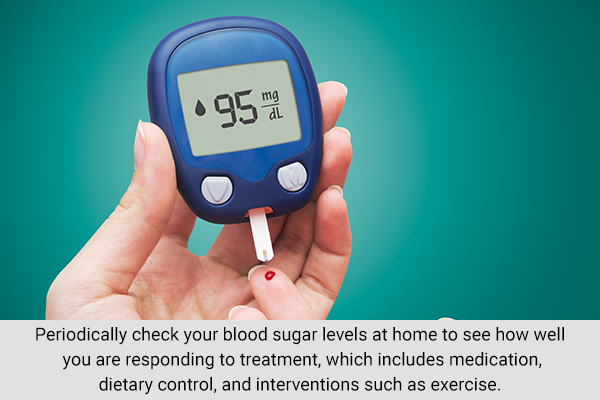In this article:
Diabetes is a chronic metabolic disorder characterized by high blood sugar levels. Your body breaks down foods into sugar or glucose, which is released into the bloodstream. This triggers the pancreas to release a hormone called insulin, which transfers the sugar from the blood into the cells to be used for energy.

Diabetes occurs when the body is unable to produce sufficient insulin or use the insulin properly to move the glucose from the blood to the cells. This causes a buildup of glucose in the blood, which damages the body in different ways and leads to severe complications if left untreated.
Although there is no cure for diabetes, it can be kept reasonably under control through medication, eating right, and an overall healthy lifestyle that puts a lot of stress on staying active.
In fact, regular exercise is one of the most commonly recommended and successful interventions for managing diabetes. It improves your body’s ability to utilize insulin to curb excess blood sugar while also improving a whole range of other health markers such as cholesterol levels, blood pressure, body mass index (BMI), muscle and bone strength, and mental well-being. (1)
Of all the forms of exercise, walking is considered to be ideal for people with diabetes given how safe, convenient, and inexpensive it is.
Walking Tips for Diabetics
Here are some useful walking tips for people who have diabetes.
1. Monitor your blood sugar at home

Periodically check your blood sugar levels at home to see how well you are responding to treatment, which includes medication, dietary control, and interventions such as exercise. This also helps your doctor rule out any adverse side effects or risks.
But there is no need to go overboard with this step. Ask your doctor about how frequently you need to get tested.
Some patients need to do it more often than others depending on the severity of their condition and other relevant factors. Meanwhile, some patients don’t need to monitor their blood sugar at home and simply get tested every 6 months or at their regular health checkups. (2)
2. Look after your feet
Prolonged or poorly managed diabetes is known to limit blood flow to the feet, which causes nerve damage leading to a gradual loss of sensation.
Thus, foot injuries may go unnoticed for a long time since you will be unable to feel any pain. Plus, the lack of blood supply in the lower extremities will also keep the injured area from healing properly. This can lead to the development of even more severe complications such as infection, ulcers, and gangrene over time.
So, it is very important to examine your feet regularly for cuts, blisters, lesions, or any unusual symptoms. Consult a podiatrist at the first sign of trouble before it becomes something serious. (3)
Going for a walk can put you at an increased risk of hurting your foot, so be extra careful.
3. Consume food timely

People with diabetes who take insulin run the risk of developing hypoglycemia, or low blood sugar levels, during exercise.
In such cases, it is important to test your blood glucose before starting the exercise. Based on this reading, you will have to take the appropriate amount of insulin and carbohydrate to stabilize your blood sugar levels during physical activity.
However, if you go on an unplanned walk such that insulin is not available, simply eating a carbohydrate snack beforehand should suffice.
You may need a snack before, during, and after the exercise depending on your initial blood glucose level as well as the duration and intensity of the exercise. Consult your doctor to understand how to adjust your insulin and carb dosage before exercise to avoid any unforeseen or severe drops in blood sugar. (4)
4. Stay hydrated
Walking triggers excessive perspiration, which makes your body lose essential fluids. Thus, it is very important to consume plenty of water while performing any physical activity to replenish the fluid loss caused by sweating and thereby avoid dehydration. (5)
Even though there are many energy drinks and juices available nowadays, water is the best choice as it is devoid of any sugar, calories, and other harmful additives, making it ideal for people with diabetes.
Moreover, proper water intake is known to improve blood sugar parameters in people with and without diabetes. (6)
5. Wash and dry your feet every day

Once you come back from a walk, wash your feet with soap and comfortably warm water (90 to 95°F) to get rid of all the sweat and grime.
Always check the water before using to make sure it’s not too hot. This is especially important for people with diabetes who often lose sensation in their feet due to reduced blood flow and may not realize the scalding effect of the water.
Also, avoid immersing your feet in water for long durations as it can make your skin too dry.
After washing, let your feet air-dry or pat them dry with a clean towel. The area between the toes is so confined that it often retains moisture and gets sweaty easily, which can increase the risk of infections. So, it is recommended that you sprinkle some talcum powder or corn starch between the toes to soak any trace of moisture. (7)
6. Wear shoes that fit well
It is very important to wear the right footwear when exercising or going for walk to minimize strain on your feet. Shoes that are too tight or too loose can lead to foot pain and injuries, which are especially dangerous for people with diabetes as mentioned earlier.
Diabetes is known to curb blood supply to the feet, making them swell up, especially after a whole day of moving about. You need to keep this in mind when buying your walking shoes to find the correct size. It’s best to try new footwear at the end of the day to make sure it fits your feet comfortably when they are at their largest.
Also, wear new shoes only for 1–2 hours a day in the beginning to soften them up such that they become comfortable around the feet. It is also important to wear socks with your shoes as they give your feet an extra layer of protection. (8)
Benefits of Walking for Diabetics
Walking is a low-impact physical activity that is a good starting point for those who are new to exercising. (9)
It has minimal risk of injury, doesn’t require any equipment, and can be done any time. All these factors make walking the most preferred exercise for people with type 2 diabetes. (10)
Research has shown that this nonpharmacological measure can lead to better glycemic control, body mass index (BMI), and overall health in people with type 2 diabetes, (11) which may help prevent other chronic complications associated with this disease. (12)
By improving your blood sugar levels, walking can help reduce your dependence on diabetes medication. Plus, it has been recognized as the most critical step in the stroke rehabilitation program of the National Institute of Health (NIH). (13)
Recommended Walking Duration for Diabetes Management
Experts recommend walking for 150 minutes weekly. You can split this total walking time into a schedule that suits you. Here are some options:
- Walking for 30 minutes at a stretch, five times a week
- Walking for 15 minutes at a stretch, 10 times a week
- Walking for 10 minutes at a stretch, several times a day such that you meet the 150 minutes/week mark (2)(14)
You may start with shorter walks, but the ultimate goal should be five 30-minute walks per week. (15)
Final Word
If you have always led a sedentary life, you have to gradually build up your stamina for exercise instead of jumping in full throttle.
Start with a short walk for just a few minutes and slowly increase your duration and speed. The idea is to stay active, not win a race. So don’t push your body too much as this will only increase the risk of injuries.
As you get in the habit of walking, your body will loosen up and allow you to pick up your pace and intensity.
- Was this article helpful?
- YES, THANKS!NOT REALLY


